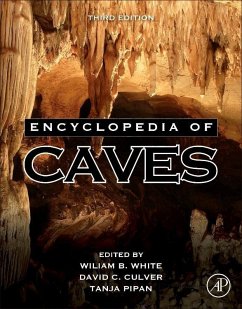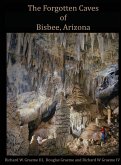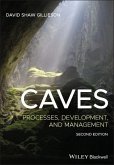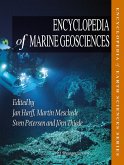Encyclopedia of Caves
Herausgeber: White, William B; Pipan, Tanja; Culver, David C
Encyclopedia of Caves
Herausgeber: White, William B; Pipan, Tanja; Culver, David C
- Broschiertes Buch
- Merkliste
- Auf die Merkliste
- Bewerten Bewerten
- Teilen
- Produkt teilen
- Produkterinnerung
- Produkterinnerung
Features 14 new chapters and 13 completely rewritten chapters Contains beautifully illustrated content, with more than 500 color images of cave life and features Provides extensive bibliographies that allow readers to access their subject of interest in greater depth
Andere Kunden interessierten sich auch für
![History of Elephanta Caves (Gharapuri) History of Elephanta Caves (Gharapuri)]() History of Elephanta Caves (Gharapuri)28,99 €
History of Elephanta Caves (Gharapuri)28,99 €![Encyclopedia of Solid Earth Geophysics 2 Volume Set Encyclopedia of Solid Earth Geophysics 2 Volume Set]() Encyclopedia of Solid Earth Geophysics 2 Volume Set623,99 €
Encyclopedia of Solid Earth Geophysics 2 Volume Set623,99 €![Forgotten Caves of Bisbee, Arizona Forgotten Caves of Bisbee, Arizona]() Richard William Graeme IIIForgotten Caves of Bisbee, Arizona51,99 €
Richard William Graeme IIIForgotten Caves of Bisbee, Arizona51,99 €![Caves Caves]() David Shaw GilliesonCaves55,99 €
David Shaw GilliesonCaves55,99 €![Encyclopedia of Coastal Science Encyclopedia of Coastal Science]() M. Schwartz (ed.)Encyclopedia of Coastal Science849,99 €
M. Schwartz (ed.)Encyclopedia of Coastal Science849,99 €![Encyclopedia of Marine Geosciences Encyclopedia of Marine Geosciences]() Encyclopedia of Marine Geosciences552,99 €
Encyclopedia of Marine Geosciences552,99 €![Encyclopedia of Scientific Dating Methods Encyclopedia of Scientific Dating Methods]() Encyclopedia of Scientific Dating Methods926,99 €
Encyclopedia of Scientific Dating Methods926,99 €-
-
-
Features 14 new chapters and 13 completely rewritten chapters Contains beautifully illustrated content, with more than 500 color images of cave life and features Provides extensive bibliographies that allow readers to access their subject of interest in greater depth
Hinweis: Dieser Artikel kann nur an eine deutsche Lieferadresse ausgeliefert werden.
Hinweis: Dieser Artikel kann nur an eine deutsche Lieferadresse ausgeliefert werden.
Produktdetails
- Produktdetails
- Verlag: Elsevier Science
- 3rd edition
- Seitenzahl: 1250
- Erscheinungstermin: 16. Mai 2019
- Englisch
- Abmessung: 274mm x 215mm x 53mm
- Gewicht: 2379g
- ISBN-13: 9780128141243
- ISBN-10: 0128141247
- Artikelnr.: 53692204
- Herstellerkennzeichnung
- Libri GmbH
- Europaallee 1
- 36244 Bad Hersfeld
- gpsr@libri.de
- Verlag: Elsevier Science
- 3rd edition
- Seitenzahl: 1250
- Erscheinungstermin: 16. Mai 2019
- Englisch
- Abmessung: 274mm x 215mm x 53mm
- Gewicht: 2379g
- ISBN-13: 9780128141243
- ISBN-10: 0128141247
- Artikelnr.: 53692204
- Herstellerkennzeichnung
- Libri GmbH
- Europaallee 1
- 36244 Bad Hersfeld
- gpsr@libri.de
A: Adaptation to low food; Adaptations: Low oxygen; Adaptation to darkness; Adaptations: Behavioral;Adaptation: Morphological; Adaptation and natural selection in caves; Adaptive shifts; Anchihaline (Anchialine) caves and fauna; Ancient cavers in Eastern North America; Art in European caves; Asellus aquaticus: A model system for historical biogeography; Astyanax mexicanus: A vertebrate model for evolution, adaptation, and development in caves B: Bats; Beetles; Biodiversity patterns in Australia; Biodiversity: China; Biodiversity in Europe; Biodiversity in the United States and Canada; Biodiversity in South America; Breakdown; Burnsville Cove, Virginia C: Camps; Castleguard Cave, Canada; Cave dwellers in Southwest Asia; Cave ecosystems; Cavefishes; Cavefish of China; Definition of cave; Caver communities and organizations: Cultural and historical considerations; Chemolithoautotrophy; Clastic sediments in caves; Closed depressions in karst areas; Coastal caves; Collembola; Contamination of cave waters by heavy metals; Contamination of cave waters by nonaqueous-phase liquids; Crustacea; Dating cave sediments with cosmogenic nuclides D: Dating cave sediments with cosmogenic nuclides; Dinaric karst-Geography and geology; Biodiversity in the tropics; Documentation and databases E: Ecological and evolutionary classifications of subterranean organisms; Entrances; Environmental DNA as a conservation tool; Epikarst; Epikarst communities; Exploration of caves-General; Exploration of caves: Underwater exploration; Exploration of caves-Vertical caving techniques F: Folklore, myth, and legend, caves in; Food sources; The Frasassi Caves, Italy; Friars Hole System G: Gammarus minus: A model system for the study of adaptation to the cave environment; Geophysics for locating karst and caves; Glacier caves; Guano communities; Gypsum caves; Gypsum flowers and related speleothems H: Hang Son Doong and other caves of the Phong Nha-K
Ba`ng karst, Qüng B
`nh Province, Vietnam; Helictites and related speleothems; History: Caves and other underground spaces in medieval Britain and Ireland; Huautla cave system (Sistema Huautla), Mexico; Hydrogeology of Karst aquifers; Hydrothermal caves I: Ice in caves; Iron formation caves: Genesis and ecology; Isotopes in karst waters and cave sediments J: Jewel cave, South Dakota K: Karren, cave; Karren, surface; Karst; Kazumura Cave, Hawaii; Krubera (Voronja) cave L: Lampenflora; Lechuguilla Cave, New Mexico; Life histories M: Magnetism of cave sediments; Mammals and birds-vertebrate visitors; Mammoth Cave System, Kentucky; Mapping subterranean biodiversity; Maya caves; Microbes; Minerals in caves; Modeling of karst aquifers; Modeling the evolution of karst aquifers; Molluscs; Mulu caves, Malaysia; Myriapods N: Niphargus-A model system for evolution and ecology; Nitrate contamination in karst groundwater; Nullarbor Caves, Australia O: The Omega Cave System; Orthoptera P: Paleoclimate records from speleothems; Paleontology of caves; Passage growth and development; Postojna-Planina Cave System, Slovenia; Protecting cave life; Protecting caves; Pseudokarst Q: Quartzite and quartz sandstone caves of South America R: Recreational caving S: Salamanders; Saltpeter mining; Scallops; Shallow subterranean habitats; Show caves; Siebenhengste cave system, Switzerland; Sinkholes; Solution caves in regions of high-relief; Solution caves in regions of moderate relief; Species interactions; Speleogenesis-Hypogen
; Speleogenesis: Telogenetic; Speleothem deposition; Speleothems; Spiders and related groups; Springs; Stalactites and stalagmites; Submarine springs in coastal karst; Sulfuric acid caves; Surveying caves T: Tiankeng, Definition of; Time markers in landscape evolution, caves as U: Ukraine giant gypsum caves; Underwater Caves of the Yucatan Peninsula; Uranium series dating of speleothems V: Vicariance and dispersal in caves; Vjetrenica Cave, Bosnia and Herzegovina; Volcanic rock caves W: Wakulla spring underwater cave system, Florida; Water chemistry in caves; Water tracing in karst aquifers; Wetlands in cave and karst regions; White-nose syndrome: A fungal disease of North American hibernating bats; Worms X: Xe Bang Fai Cave, Laos
Ba`ng karst, Qüng B
`nh Province, Vietnam; Helictites and related speleothems; History: Caves and other underground spaces in medieval Britain and Ireland; Huautla cave system (Sistema Huautla), Mexico; Hydrogeology of Karst aquifers; Hydrothermal caves I: Ice in caves; Iron formation caves: Genesis and ecology; Isotopes in karst waters and cave sediments J: Jewel cave, South Dakota K: Karren, cave; Karren, surface; Karst; Kazumura Cave, Hawaii; Krubera (Voronja) cave L: Lampenflora; Lechuguilla Cave, New Mexico; Life histories M: Magnetism of cave sediments; Mammals and birds-vertebrate visitors; Mammoth Cave System, Kentucky; Mapping subterranean biodiversity; Maya caves; Microbes; Minerals in caves; Modeling of karst aquifers; Modeling the evolution of karst aquifers; Molluscs; Mulu caves, Malaysia; Myriapods N: Niphargus-A model system for evolution and ecology; Nitrate contamination in karst groundwater; Nullarbor Caves, Australia O: The Omega Cave System; Orthoptera P: Paleoclimate records from speleothems; Paleontology of caves; Passage growth and development; Postojna-Planina Cave System, Slovenia; Protecting cave life; Protecting caves; Pseudokarst Q: Quartzite and quartz sandstone caves of South America R: Recreational caving S: Salamanders; Saltpeter mining; Scallops; Shallow subterranean habitats; Show caves; Siebenhengste cave system, Switzerland; Sinkholes; Solution caves in regions of high-relief; Solution caves in regions of moderate relief; Species interactions; Speleogenesis-Hypogen
; Speleogenesis: Telogenetic; Speleothem deposition; Speleothems; Spiders and related groups; Springs; Stalactites and stalagmites; Submarine springs in coastal karst; Sulfuric acid caves; Surveying caves T: Tiankeng, Definition of; Time markers in landscape evolution, caves as U: Ukraine giant gypsum caves; Underwater Caves of the Yucatan Peninsula; Uranium series dating of speleothems V: Vicariance and dispersal in caves; Vjetrenica Cave, Bosnia and Herzegovina; Volcanic rock caves W: Wakulla spring underwater cave system, Florida; Water chemistry in caves; Water tracing in karst aquifers; Wetlands in cave and karst regions; White-nose syndrome: A fungal disease of North American hibernating bats; Worms X: Xe Bang Fai Cave, Laos
A: Adaptation to low food; Adaptations: Low oxygen; Adaptation to darkness; Adaptations: Behavioral;Adaptation: Morphological; Adaptation and natural selection in caves; Adaptive shifts; Anchihaline (Anchialine) caves and fauna; Ancient cavers in Eastern North America; Art in European caves; Asellus aquaticus: A model system for historical biogeography; Astyanax mexicanus: A vertebrate model for evolution, adaptation, and development in caves B: Bats; Beetles; Biodiversity patterns in Australia; Biodiversity: China; Biodiversity in Europe; Biodiversity in the United States and Canada; Biodiversity in South America; Breakdown; Burnsville Cove, Virginia C: Camps; Castleguard Cave, Canada; Cave dwellers in Southwest Asia; Cave ecosystems; Cavefishes; Cavefish of China; Definition of cave; Caver communities and organizations: Cultural and historical considerations; Chemolithoautotrophy; Clastic sediments in caves; Closed depressions in karst areas; Coastal caves; Collembola; Contamination of cave waters by heavy metals; Contamination of cave waters by nonaqueous-phase liquids; Crustacea; Dating cave sediments with cosmogenic nuclides D: Dating cave sediments with cosmogenic nuclides; Dinaric karst-Geography and geology; Biodiversity in the tropics; Documentation and databases E: Ecological and evolutionary classifications of subterranean organisms; Entrances; Environmental DNA as a conservation tool; Epikarst; Epikarst communities; Exploration of caves-General; Exploration of caves: Underwater exploration; Exploration of caves-Vertical caving techniques F: Folklore, myth, and legend, caves in; Food sources; The Frasassi Caves, Italy; Friars Hole System G: Gammarus minus: A model system for the study of adaptation to the cave environment; Geophysics for locating karst and caves; Glacier caves; Guano communities; Gypsum caves; Gypsum flowers and related speleothems H: Hang Son Doong and other caves of the Phong Nha-K
Ba`ng karst, Qüng B
`nh Province, Vietnam; Helictites and related speleothems; History: Caves and other underground spaces in medieval Britain and Ireland; Huautla cave system (Sistema Huautla), Mexico; Hydrogeology of Karst aquifers; Hydrothermal caves I: Ice in caves; Iron formation caves: Genesis and ecology; Isotopes in karst waters and cave sediments J: Jewel cave, South Dakota K: Karren, cave; Karren, surface; Karst; Kazumura Cave, Hawaii; Krubera (Voronja) cave L: Lampenflora; Lechuguilla Cave, New Mexico; Life histories M: Magnetism of cave sediments; Mammals and birds-vertebrate visitors; Mammoth Cave System, Kentucky; Mapping subterranean biodiversity; Maya caves; Microbes; Minerals in caves; Modeling of karst aquifers; Modeling the evolution of karst aquifers; Molluscs; Mulu caves, Malaysia; Myriapods N: Niphargus-A model system for evolution and ecology; Nitrate contamination in karst groundwater; Nullarbor Caves, Australia O: The Omega Cave System; Orthoptera P: Paleoclimate records from speleothems; Paleontology of caves; Passage growth and development; Postojna-Planina Cave System, Slovenia; Protecting cave life; Protecting caves; Pseudokarst Q: Quartzite and quartz sandstone caves of South America R: Recreational caving S: Salamanders; Saltpeter mining; Scallops; Shallow subterranean habitats; Show caves; Siebenhengste cave system, Switzerland; Sinkholes; Solution caves in regions of high-relief; Solution caves in regions of moderate relief; Species interactions; Speleogenesis-Hypogen
; Speleogenesis: Telogenetic; Speleothem deposition; Speleothems; Spiders and related groups; Springs; Stalactites and stalagmites; Submarine springs in coastal karst; Sulfuric acid caves; Surveying caves T: Tiankeng, Definition of; Time markers in landscape evolution, caves as U: Ukraine giant gypsum caves; Underwater Caves of the Yucatan Peninsula; Uranium series dating of speleothems V: Vicariance and dispersal in caves; Vjetrenica Cave, Bosnia and Herzegovina; Volcanic rock caves W: Wakulla spring underwater cave system, Florida; Water chemistry in caves; Water tracing in karst aquifers; Wetlands in cave and karst regions; White-nose syndrome: A fungal disease of North American hibernating bats; Worms X: Xe Bang Fai Cave, Laos
Ba`ng karst, Qüng B
`nh Province, Vietnam; Helictites and related speleothems; History: Caves and other underground spaces in medieval Britain and Ireland; Huautla cave system (Sistema Huautla), Mexico; Hydrogeology of Karst aquifers; Hydrothermal caves I: Ice in caves; Iron formation caves: Genesis and ecology; Isotopes in karst waters and cave sediments J: Jewel cave, South Dakota K: Karren, cave; Karren, surface; Karst; Kazumura Cave, Hawaii; Krubera (Voronja) cave L: Lampenflora; Lechuguilla Cave, New Mexico; Life histories M: Magnetism of cave sediments; Mammals and birds-vertebrate visitors; Mammoth Cave System, Kentucky; Mapping subterranean biodiversity; Maya caves; Microbes; Minerals in caves; Modeling of karst aquifers; Modeling the evolution of karst aquifers; Molluscs; Mulu caves, Malaysia; Myriapods N: Niphargus-A model system for evolution and ecology; Nitrate contamination in karst groundwater; Nullarbor Caves, Australia O: The Omega Cave System; Orthoptera P: Paleoclimate records from speleothems; Paleontology of caves; Passage growth and development; Postojna-Planina Cave System, Slovenia; Protecting cave life; Protecting caves; Pseudokarst Q: Quartzite and quartz sandstone caves of South America R: Recreational caving S: Salamanders; Saltpeter mining; Scallops; Shallow subterranean habitats; Show caves; Siebenhengste cave system, Switzerland; Sinkholes; Solution caves in regions of high-relief; Solution caves in regions of moderate relief; Species interactions; Speleogenesis-Hypogen
; Speleogenesis: Telogenetic; Speleothem deposition; Speleothems; Spiders and related groups; Springs; Stalactites and stalagmites; Submarine springs in coastal karst; Sulfuric acid caves; Surveying caves T: Tiankeng, Definition of; Time markers in landscape evolution, caves as U: Ukraine giant gypsum caves; Underwater Caves of the Yucatan Peninsula; Uranium series dating of speleothems V: Vicariance and dispersal in caves; Vjetrenica Cave, Bosnia and Herzegovina; Volcanic rock caves W: Wakulla spring underwater cave system, Florida; Water chemistry in caves; Water tracing in karst aquifers; Wetlands in cave and karst regions; White-nose syndrome: A fungal disease of North American hibernating bats; Worms X: Xe Bang Fai Cave, Laos








